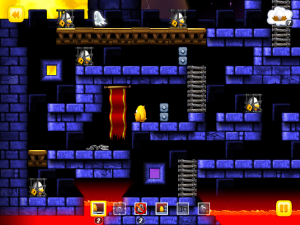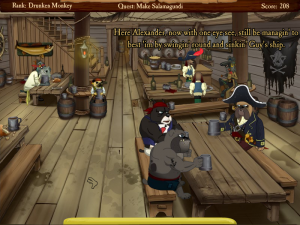OK, I’m interrupting the expedition to Syberia. I intend to get back to it soon. But for now, Steam is having another one of its promotions. Like last year’s “Treasure Hunt” (or this year’s “Potato Sack” promotion for Portal 2, which I sat out), it involves earning rewards via special Achievements in various games. And as before, I’m not particularly interested in the rewards, but I find the Achievements appealing. I don’t intend to buy any games just for the promotion, but I’ll certainly be trying for the Achievements in the games that I already have.
Day 1 of the promotion featured two such games, AaaaaAAaaaAAAaaAAAAaAAAAA!!!, which was also featured in Day 1 of the previous promotion (perhaps because it tends to come up first in alphabetical listings), and Swords & Soldiers, a game I know nothing about which I got in a recent Indie bundle. (For my money, games that I know nothing about are pretty much the point of those bundles.) AaaaaAAaaaAAAaaAAAAaAAAAA!!!‘s new Achievement is to complete a special level with a five-star rating, and I made some attempts at this, but found it difficult; on a couple of tries, I came close enough that I would have succeeded if I didn’t keep smashing into things so much. This was frustrating enough that I took a break with S&S, which proved engaging enough that I wound up playing all the way through campaign mode for all three of its sides.
S&S is a port of a WiiWare game, but to my newly-sensitized-to-iOS eyes, it seems like it was developed with an eventual phone port in mind. Everything about the UI is extremely touchscreen-friendly. What’s more, it seems like a pretty good example of a post-Angry Birds iPhone game, or at least part of the same stylistic trend as Angry Birds: it’s all broad slapstick and extreme stylization. I just described the caricature in Syberia as restrained. There’s no sense of restraint in S&S. It’s a story of three childish nations warring over things like barbecue sauce and toys. The three sides, in the order they become available for play, are the Vikings, the Aztecs, and the Chinese, all thoroughly stereotyped, which strikes me as especially problematic in the case of the Chinese, who still exist. (Sure, descendants of Aztecs and Vikings exist, but the Aztec civilization is long gone, and Viking was always more of an occupation than a race.) The Chinese here speak in pidgin, they say things like “Ah, chop chop” when summoned, their swordsmen wear conical straw hats (which as far as I’m aware have never been part of any military uniform), etc. So it’s not even current stereotyping, but more like Chinese stereotypes from the 1930s, which is probably why the authors thought it was acceptable. For my part, as a white guy, it’s not my place to be offended on other people’s behalf, but it’s nonetheless too embarrassing to pass without comment, and for that reason has engendered some painfully clueless arguments about racism on the Steam forums (content warning: “It’s just a game” used).
Regardless, the gameplay is interesting. It’s essentially an RTS with asymmetric sides. It’s also a simplification of the genre, like Eufloria but in a completely different way. The biggest simplification is that the map is one-dimensional. Some maps have bits where the path splits for a while and rejoins, with a railroad-like switch at the branch point to tell your units which way to go, but even there, within the path you choose, you’re fighting for distance along a line. Furthermore, you have no direct control over your units. Whenever they’re not fighting, they’re moving from left to right. As is normal for an RTS, the simplest way to win fights is to have lots of units together, but the fact that they all go running off the moment they’re summoned tends to work against this approach. Each stereotype has different ways around this. For example, the Vikings, the most straightforward side, have a healing spell that you can use to help your frontmost warrior survive in combat until the guys behind him catch up, while the Chinese have a spell that duplicates a unit, letting you build a posse out of one guy. The Aztecs have necromancer units that can turn corpses into animated skeletons, so each guy that pulls ahead and gets killed gets to be part of an undead horde later.
The interesting part is how little these simplifications change things. In practice, RTS-style gameplay often reduces to a fight along a single path between two bases, each side throwing all they’ve got at it, trying to counter the opponent’s offense efficiently enough to have resources to spare on an effective offense of their own. S&S takes that moment and turns it into the entirety of the game. And it works pretty well. It’s essentially a game of tradeoffs. You’ve got the tradeoffs between current troop strength and research into more powerful stuff, you have to increase your gold-collection rate by spending current gold, and in the later levels of their campaigns, each side develops their own megaweapon that they can use if they can refrain from casting other spells long enough to afford its mana cost. The Aztecs can even sacrifice their own units to gain a little mana, but I suppose that’s essentially the same choice every side makes when they decide whether to cast a defensive spell to save a unit’s life or not. Apparently there are some gambits that are extremely difficult to counter, so two-player play might not be all that interesting in the long run. But the single-player campaign remains interesting and varied for as long as it lasts, which was about six hours for me.
 Comments(1)
Comments(1)
